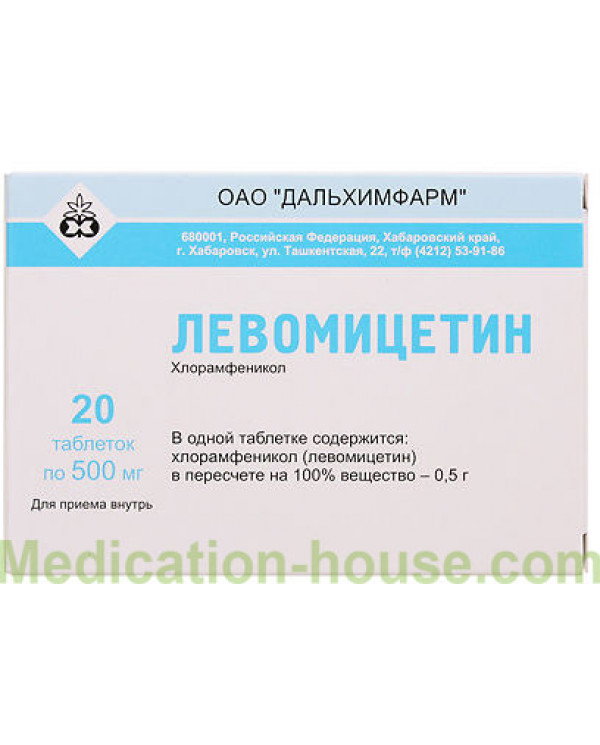Instruction for Levomycetin
You can buy Levomycetin here
The tool is almost instantly and without residue absorbed from the stomach and enters the blood. The maximum concentration is reached in the range of one to three hours.
Composition and release form
Pharmacological action: broad-spectrum antibiotic. Levomycetin released in the form of:
Yellowish round tablets Levomycetin, containing 0.5 g and 0.25 g of the active substance levomycetin. Excipients - stearic acid or calcium stearic acid, potato starch;
A drop of eye 0.25%. 1 ml of the preparation contains 2.5 mg of active ingredient. In dropper bottles of 5 and 10 ml.
Powder for solution for injection. Each bottle contains 500 or 1000 mg of active ingredient.
Active against gram-positive bacteria: Staphylococcus spp., Streptococcus spp .; Gram-negative bacteria: Neisseria gonorrhoeae, Neisseria meningitidis, Escherichia coli, Haemophilus influenzae, Salmonella spp., Shigella spp., Klebsiella spp., Serratia spp., Yersinia spp., Proteus spp., Rickettsia spp. is also active against Spirochaetaceae, some major viruses.
What is Levomycetin used for?
Used for the treatment of patients with infectious diseases caused by microorganisms susceptible to the action of chloramphenicol. The drug is prescribed in case of ineffectiveness or impossibility of using other antimicrobial agents for such diseases:
Persiniosis
Generalized forms of salmonella;
Paratyphus;
Tularemia;
Rickettsios;
Brucellosis;
Typhoid fever;
Meningitis;
Chlamydia.
In case of infectious diseases of other etiology, which are caused by pathogens sensitive to the drug, Levomycetin is indicated with the ineffectiveness of other chemotherapeutic agents or in cases when their use is impossible due to individual intolerance.
In ophthalmology, chloramphenicol is indicated for the prevention and treatment of infectious eye diseases:
Blepharitis;
Conjunctivitis;
Keratitis.
Pharmacological properties
Levomycetin - an antimicrobial drug effective against a wide range of gram-positive and gram-negative microorganisms.
It has a pronounced bacteriostatic effect, in high concentrations in relation to some strains exhibits a bactericidal effect. The mechanism of action is based on the ability to bind to the 50S subunit of bacterial ribosomes and inhibit the synthesis of proteins in bacterial cells.
Instructions for use
According to the instructions for use Levomycetin tablets are applied orally for half an hour before meals.
Usually adults take 1-2 tablets of chloramphenicol (0.25 g each) 3-4 times a day, but not more than 2 g of the drug per day. In severe cases, the maximum dose may be 4 g, divided into 3-4 doses, under strict control of liver and kidney function and blood condition.
A single dose of chloramphenicol for children up to 3 years is calculated on the basis of weight - 10-15 mg per 1 kg, children 3-8 years - 0.15-2 g, older children - 0.2-0.3 mg per 1 kg masses. A single dose of chloramphenicol in children is taken from 3 to 4 times a day, depending on the course of the disease.
The duration of treatment with chloramphenicol according to the instructions is 7-10 days, and in some cases, with good tolerability and no side effects, up to two weeks.
When applied topically applied to gauze tampons or directly on the affected area. From above apply a usual bandage, it is possible with parchment or compress paper. Ligation produced depending on the evidence in 1-3 days, sometimes after 4-5 days.
Locally used in ophthalmology as part of combined preparations in accordance with the indications.
Levomycetin drops. The drug is instilled into the conjunctival sac 1 drop 3-4 times / day. If the patient applies the drug at its discretion, then it is not recommended to use it for more than three days without consulting a doctor.
Contraindications for Levomycetin
Increased individual sensitivity to the components of the drug, as well as thiamphenicol and azidamphenicol.
Levomycetin is contraindicated in patients suffering from hematopoietic dysfunction, severe liver and / or kidney diseases, and deficiency of glucose-6-phosphate dehydrogenase.
The drug is not prescribed to patients with fungal skin diseases, psoriasis, eczema, porphyria, as well as acute respiratory infections, including angina.
The drug is not used to prevent infectious complications during surgery.
Pregnancy and lactation
Chloramphenicol is contraindicated for use during pregnancy and lactation (breastfeeding).
Side effects of Levomycetin
Possible side effects of the drug when administered or parenteral:
Nervous system: confusion, depression, peripheral neuritis, visual and auditory hallucinations, psychomotor disorders, headache, decreased visual acuity and hearing, optic neuritis;
Cardiovascular system: change in blood pressure, collapse;
Allergic reactions: rash, pruritus, dermatosis, urticaria, angioedema;
Hematopoietic organs: thrombocytopenia, granulocytopenia, erythrocytopenia, leukopenia, reticulocytopenia; rarely - agranulocytosis, aplastic anemia;
The digestive system: diarrhea, dysbacteriosis, irritation of the oral mucosa and pharynx, nausea and vomiting (you can prevent their development by taking the drug 1 hour after eating), dyspepsia;
Others: secondary fungal infection, dermatitis, Jarish-Herxheimer's reaction, fever, cardiovascular collapse, superinfection.
Possible side effects with external use of chloramphenicol:
Blood forming organs: rarely - leukopenia, reticulocytopenia, granulocytopenia, agranulocytosis, thrombocytopenia, erythropenia, aplastic anemia;
Allergic reactions: skin rash, angioedema.
Overdose
With an overdose of the drug, blood formation may be impaired, which manifests itself in an increase in body temperature, pallor, weakness, fatigue, sore throat, bleeding and hematomas.
In children and patients with a weakened body, bloating, nausea, vomiting are also possible, the skin becomes grayish, cardiovascular collapse and respiratory distress occur with metabolic acidosis. Exceeding the recommended dose of the drug can cause impaired vision and hearing, a slowing down of the psychomotor reaction and hallucinations. When observing these symptoms, it is recommended that the abolition of the drug, gastric lavage and enterosorbent taking.
Use in childhood
Chloramphenicol is not used in newborns, because “gray syndrome” may develop (flatulence, nausea, hypothermia, gray-blue skin color, progressive cyanosis, dyspnea, cardiovascular insufficiency).
Storage conditions
In the place protected from moisture and light at a temperature not higher than 25 ° C. Keep out of the reach of children. Shelf life 3 years. Do not use after the expiration date.
Terms of sell
You don't need a prescription to buy Levomycetin.

